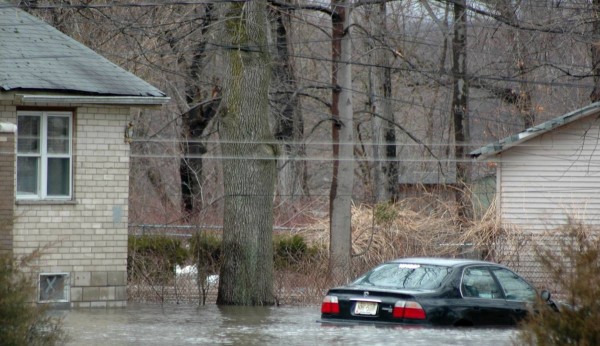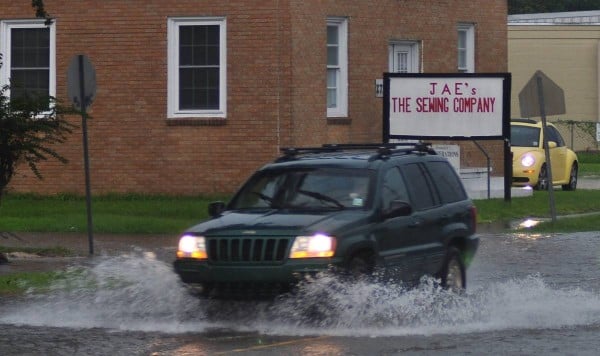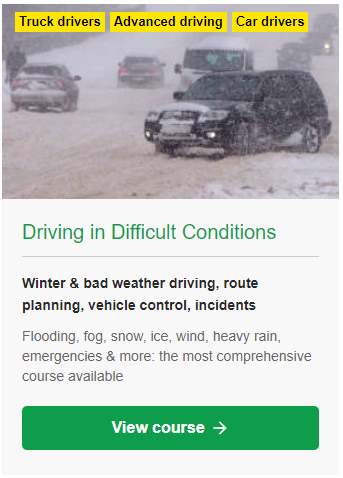
Flooding can happen at any time of the year. It occurs when the input of water is greater than drainage can take away. This can be caused by local rain, or by a river bursting its banks from rain upstream. On a very local level, it can be caused by a burst water main.
Flooding is a large area of deep water. It could be standing (i.e. still), or it might be moving. Moving water in a flood is much more dangerous.
If you come across flood water, how do you know if you can drive through it?
If emergency services have attended the flooding you might see a sign like this:

Driving into deep water at speed is like driving into a wall. The resistance of the water will slow your vehicle down extremely quickly. Water will be pushed in a wave ahead of your vehicle, entering into the bonnet and could be forced into the engine, damaging parts (water doesn’t compress, so if just an egg cup full gets into your pistons, it will bend a con rod).
Water in the engine bay can short out electrics.
Assessing the danger of crossing a flooded area
If you have an SUV, ute or vehicle with raised suspension you will be able to pass through water that is deeper than a standard car will pass through.
At six inches, or around 15cm, water will be at the door sills of a standard car. At 30cm many cars will start to float, reducing their grip on the road. At 60cm (2 feet) most vehicles will be swept away if the water is moving.
Water flowing at more than 7kph that is around waist height will sweep everyone off their feet. Even water that is only 15cm deep is enough to sweep many people away if it’s fast enough.
Therefore it’s important that you follow the steps below before going through floods or deep water.

Only cross a flooded area if you absolutely must. Don’t do it just for fun as you might end up with an expensive repair bill, or worse, with loss of life. In some cases, your insurance company might not cover you for damage. If you are driving a company vehicle, you’ll need to know their policy on driving through deep water.
If there is no other traffic around, wade through the affected area, but only if the water is not moving. You need to know how deep it is at all points, whether there is still road underneath the water and whether there’s any debris that has been washed there that could damage your tyres or the underside of your car. Swirling water can create sinkholes and wash sections of the road away.
Is the water still rising? If so, are you putting yourself in danger? Remember that your vehicle is replaceable whereas you aren’t.
If there are other vehicles waiting, watch a more capable vehicle traverse the flood and check the level on their tyres. If a vehicle passes through that is similar to yours with no problems, it might be safe.
Basic physics says that if the speed of your vehicle or the speed of the water doubles, the force on your vehicle is increased four times.
How to cross the flooded area
Approach the flood at no more than 5kph in a high gear, keeping the revs high (slip the clutch in a manual vehicle). This is to keep as much pressure as possible in the exhaust to stop water running back up the exhaust into the engine. Do not change gear as the change in manifold pressure can suck water in.
The water will exert pressure on your vehicle. Keep a consistent speed of around 5kph. If you speed up you will overtake your bow wave, forcing water into your engine bay.
Don’t speed through the flood. Speeding causes a bow wave which can wash into other vehicles, other people’s property and over pedestrians.
Drive in the middle of the road as it will be slightly higher than the edges.
Stay out of the way of other vehicles. If a vehicle is coming in the other direction, let it past first so that your two bow waves don’t meet. If you are following another vehicle, wait for it to clear the flood; if it stalls or becomes stranded you don’t want to be trapped behind it as it will be very difficult to reverse out of the flood.
To learn more thoroughly about driving in bad weather (including flooding), the Driving in Difficult Conditions course covers that and every other type of bad weather and road condition you’d ever come across.
This is how it can all go very wrong (language NSFW)


